Human Dental Pulp Tissue during Orthodontic Tooth Movement: An Immunofluorescence Study
Abstract
1. Introduction
2. Materials and Methods
2.1. Patients Selection
2.2. Clinical Procedures
2.3. Immunofluorescence
2.4. Statistic Analysis
3. Results and Discussions
4. Conclusions
Author Contributions
Funding
Conflicts of Interest
References
- Anastasi, G.; Cordasco, G.; Matarese, G.; Nucera, R.; Rizzo, G.; Mazza, M.; Militi, A.; Portelli, M.; Cutroneo, G.; Favaloro, A. An immunohistochemical, histological, and electron-microscopic study of the human periodontal ligament during orthodontic treatment. Int. J. Mol. Med. 2008, 21, 545–554. [Google Scholar] [CrossRef] [PubMed]
- Militi, A.; Cutroneo, G.; Favaloro, A.; Matarese, G.; Di Mauro, D.; Lauritano, F.; Centofanti, A.; Cervino, G.; Nicita, F.; Bramanti, A.; et al. An Immunofluorescence Study on VEGF and Extracellular Matrix Proteins in Human Periodontal Ligament during Tooth Movement. Heliyon 2019, 5, e02572. [Google Scholar] [CrossRef] [PubMed]
- Baumrind, S. A reconsideration of the propriety of the “pressure-tension” hypothesis. Am. J. Orthod. 1969, 55, 12–22. [Google Scholar] [CrossRef]
- Cutroneo, G.; Centofanti, A.; Speciale, F.; Rizzo, G.; Favaloro, A.; Santoro, G.; Bruschetta, D.; Milardi, D.; Micali, A.; Di Mauro, D.; et al. Sarcoglycan Complex in Masseter and Sternocleidomastoid Muscles of Baboons: An Immunohistochemical Study. Eur. J. Histochem. 2015, 59, 2509. [Google Scholar] [CrossRef] [PubMed]
- Cutroneo, G.; Vermiglio, G.; Centofanti, A.; Rizzo, G.; Runci, M.; Favaloro, A.; Piancino, M.G.; Bracco, P.; Ramieri, G.; Bianchi, F.; et al. Morphofunctional Compensation of Masseter Muscles in Unilateral Posterior Crossbite Patients. Eur. J. Histochem. 2016, 60, 2605. [Google Scholar] [CrossRef] [PubMed]
- Abtahi, M.; Eslami, N.; Abadi, R.Z.M.; Rezaei, S.P. The Effect of Intrusive Orthodontic Force on Dental Pulp of Adults versus Adolescents. Dent. Res. J. 2016, 13, 367–372. [Google Scholar]
- Javed, F.; Al-Kheraif, A.; Romanos, E.A.; Romanos, G.E. Influence of Orthodontic Forces on Human Dental Pulp: A Systematic Review. Arch. Oral Boil. 2015, 60, 347–356. [Google Scholar] [CrossRef]
- Abella, F.; Patel, S.; Duran-Sindreu, F.; Mercadè, M.; Bueno, R.; Roig, M. An Evaluation of the Periapical Status of Teeth with Necrotic Pulps Using Periapical Radiography and Cone-Beam Computed Tomography. Int. Endod. J. 2013, 47, 387–396. [Google Scholar] [CrossRef]
- Lazzaretti, D.; Bortoluzzi, G.; Torres Fernandez, L.; Rodriguez, R.; Grehs, R.; Hartmann Martins, M.S. Histologic Evaluation of Human Pulp Tissue After Orthodontic Intrusion. J. Endod. 2014, 40, 1537–1540. [Google Scholar] [CrossRef]
- Han, G.; Hu, M.; Zhang, Y.; Jiang, H. Pulp Vitality and Histologic Changes in Human Dental Pulp after the Application of Moderate and Severe Intrusive Orthodontic Forces. Am. J. Orthod. Dentofac. Orthop. 2013, 144, 518–522. [Google Scholar] [CrossRef]
- Subay, R.K.; Kaya, H.; Tarim, B.; Subay, A.; Cox, C.F. Response of Human Pulpal Tissue to Orthodontic Extrusive Applications. J. Endod. 2001, 27, 508–511. [Google Scholar] [CrossRef] [PubMed]
- Kindelan, S.A.; Day, P.; Kindelan, J.; Spencer, J.; Duggal, M.J. Dental Trauma: An Overview of Its Influence on the Management of Orthodontic Treatment. J. Orthod. 2008, 35, 68–78. [Google Scholar] [CrossRef] [PubMed]
- Massaro, C.; Consolaro, R.B.; Santamaria, M.; Martins-Ortiz Consolaro, M.F.; Consolaro, A. Analysis of the Dentin-Pulp Complex in Teeth Submitted to Orthodontic Movement in Rats. J. Appl. Oral Sci. 2009, 17, 35–42. [Google Scholar] [CrossRef] [PubMed]
- Tripuwabhrut, P.; Brudvik, P.; Fristad, I.; Rethnam, S. Experimental Orthodontic Tooth Movement and Extensive Root Resorption: Periodontal and Pulpal Changes. Eur. J. Oral Sci. 2010, 118, 596–603. [Google Scholar] [CrossRef]
- Ren, Y.; Maltha, J.; Kuijpers-jagtman, A.M. Optimum Force Magnitude for Orthodontic Tooth Movement: A Systematic Literature Review. Angle Orthod. 2003, 73, 86–92. [Google Scholar]
- Sabuncuoglu, F.A.; Ersahan, S. Changes in maxillary molar pulp blood flow during orthodontic intrusion. Aust. Orthod. J. 2014, 30, 152–160. [Google Scholar]
- De Ponte, F.S.; Catalfamo, L.; Micali, G.; Runci, M.; Cutroneo, G.; Vermiglio, G.; Centofanti, A.; Rizzo, G. Effect of Bisphosphonates on the Mandibular Bone and Gingival Epithelium of Rats Without Tooth Extraction. Exp. Ther. Med. 2016, 11, 1678–1684. [Google Scholar] [CrossRef]
- De Ponte, F.S.; Cutroneo, G.; Falzea, R.; Rizzo, G.; Catalfamo, L.; Favaloro, A.; Vermiglio, G.; Runci, M.; Centofanti, A.; Anastasi, G. Histochemical and Morphological Aspects of Fresh Frozen Bone: A Preliminary Study. Eur. J. Histochem. 2016, 60, 2642. [Google Scholar] [CrossRef]
- Irrera, N.; Arcoraci, V.; Mannino, F.; Vermiglio, G.; Pallio, G.; Minutoli, L.; Bagnato, G.; Anastasi, G.P.; Mazzon, E.; Bramanti, P.; et al. Activation of A2A Receptor by PDRN Reduces Neuronal Damage and Stimulates WNT/β-CATENIN Driven Neurogenesis in Spinal Cord Injury. Front. Pharmacol. 2018, 9, 506. [Google Scholar] [CrossRef]
- Di Domenico, M.; D’Apuzzo, F.; Feola, A.; Cito, L.; Monsurrò, A.; Pierantoni, G.M.; Berrino, L.; De Rosa, A.; Polimeni, A.; Perillo, L. Cytokines and VEGF Induction in Orthodontic Movement in Animal Models. J. Biomed. Biotechnol. 2012, 2012, 201689. [Google Scholar] [CrossRef]
- De Ponte, F.S.; Favaloro, A.; Nastro Siniscalchi, E.; Centofanti, A.; Runci, M.; Cutroneo, G.; Catlfamo, L. Sarcoglycans and Integrins in Bisphosphonate Treatment: Immunohistochemical and Scanning Electron Microscopy Study. Oncol. Rep. 2013, 30, 2639–2646. [Google Scholar] [CrossRef] [PubMed]
- Leonardi, R.; Talic, N.F.; Loreto, C. MMP-13 (collagenase 3) immunolocalization during initial orthodontic tooth movement in rats. Acta Histochem. 2007, 109, 215–220. [Google Scholar] [CrossRef] [PubMed]
- Muraglia, S.; Musumeci, G.; Loreto, C.; Leonardi, R.M. Role of ADAMTS4 and ADAMTS5 during early orthodontic tooth movement. J. Biol. Regul. Homeost. Agents 2019, 33, 649–655. [Google Scholar]
- Consolaro, A.; Consolaro, R.B. There is no pulp necrosis or calcific metamorphosis of pulp induced by orthodontic treatment: Biological basis. Dent. Press J. Orthod. 2018, 23, 36–42. [Google Scholar] [CrossRef]
- Uribe, F.; Dutra, E.; Chandhoke, T. Effect of cyclical forces on orthodontic tooth movement from animals to humans. Orthod. Cranio-fac. Res. 2017, 20, 68–71. [Google Scholar] [CrossRef]
- Wenjing, Y.; Zhang, Y.; Jiang, C.; Wei, H.; Yating, Y.; Jun, W. Orthodontic treatment mediates dental pulp microenvironment via IL17A. Arch. Oral Boil. 2016, 66, 22–29. [Google Scholar]
- Popescu, M.R.; Deva, V.; Dragomir, L.P.; Searpe, M.; Vătu, M.; Stefârţă, A.; Rauten, A.M. Study on the Histopathological Modifications of the Dental Pulp in Occlusal Trauma. Rom. J. Morphol. Embryol. 2011, 52, 425–430. [Google Scholar]
- Hui, T.; Zhao, Y.; Yang, J.; Ye, L.; Wang, C. EZH2 regulates dental pulp inflammation by direct effect on inflammatory factors. Arch. Oral Boil. 2018, 85, 16–22. [Google Scholar] [CrossRef]
- Timpl, R.; Wiedemann, H.; Van Delden, V.; Furthmayr, H.; Kuhn, K. A network model for the organization of type IV collagen molecules in basement membranes. Eur. J. Biochem. 1981, 120, 203–211. [Google Scholar] [CrossRef]
- Engel, J.; Odermatt, E.; Engel, A.; Madri, J.A.; Furthmay, H.; Rohde, H.; Timpl, R. Shapes, domain, organizations and flexibility of laminin and fibronectin, two multifunctional proteins of the extracellular matrix. J. Mol. Boil. 1981, 150, 97–120. [Google Scholar] [CrossRef]
- Lew, K.K. Orthodontically induced microvascular injuries in the tension zone of the periodontal ligament. J. Nihon Univ. Sch. Dent. 1989, 31, 493–501. [Google Scholar] [CrossRef] [PubMed]
- Kaku, M.; Motokawa, M.; Tohma, Y.; Tsuka, N.; Koseki, H.; Sunagawa, H.; Arturo Marquez Hernandes, R.; Ohtani, J.; Fujita, T.; Kawata, T.; et al. VEGF and M-CSF levels in periodontal tissue during tooth movement. Biomed. Res. 2008, 29, 181–187. [Google Scholar] [CrossRef] [PubMed]
- Salomao, M.F.; Reis, S.R.; Vale, V.L.; Machado, C.V.; Meyer, R.; Nascimento, I.L. Immunolocalization of FGF-2 and VEGF in rat periodontal ligament during experimental tooth movement. Dent. Press J. Orthod. 2014, 19, 67–74. [Google Scholar] [CrossRef] [PubMed]
- Lo Giudice, R.; Nicita, F.; Puleio, F.; Alibrandi, A.; Cervino, G.; Lizio, A.S.; Pantaleo, G. Accuracy of periapical radiography and CBCT in endodontic evaluation. Int. J. Dent. 2018, 2018, 2514243. [Google Scholar] [CrossRef] [PubMed]
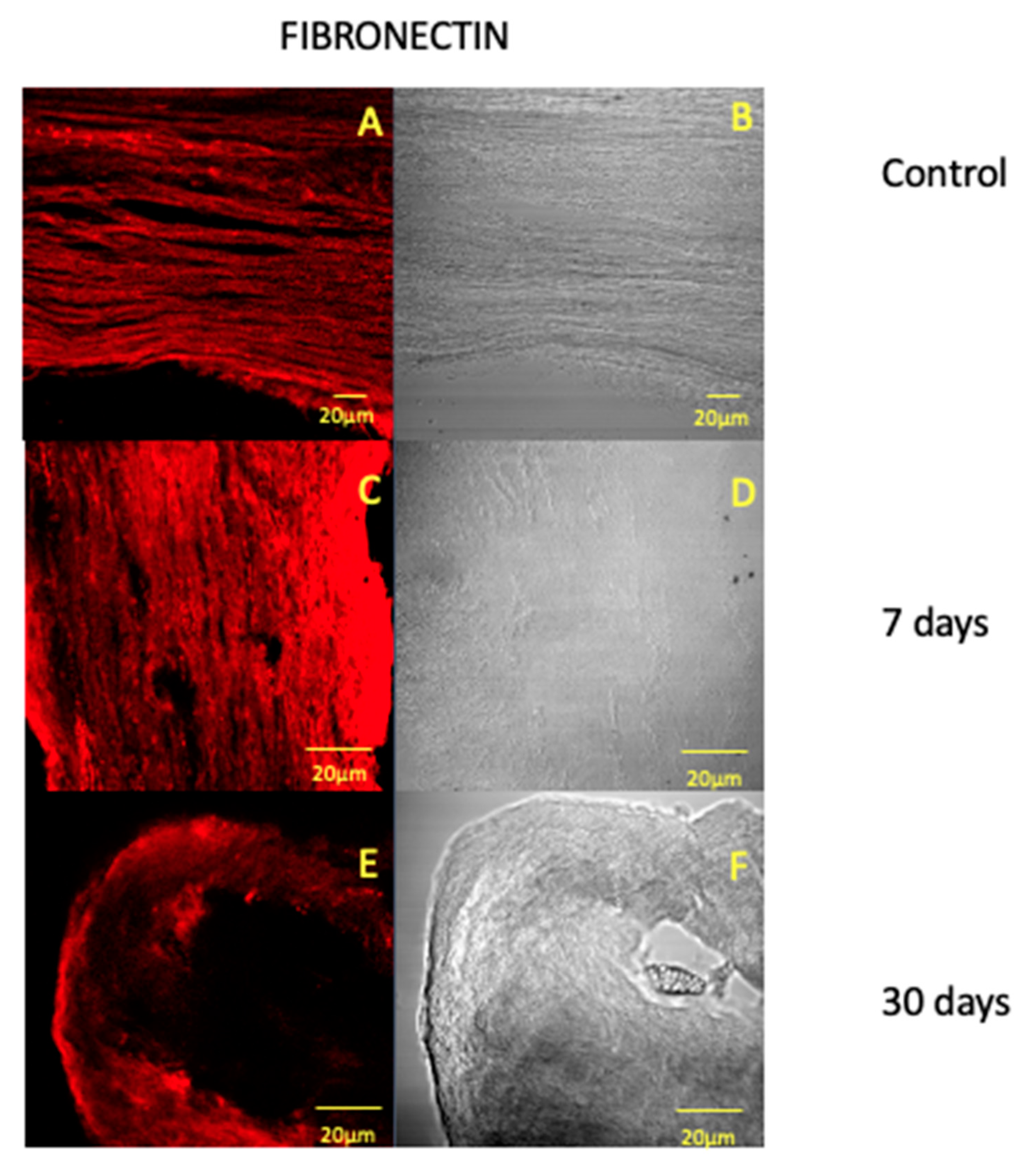
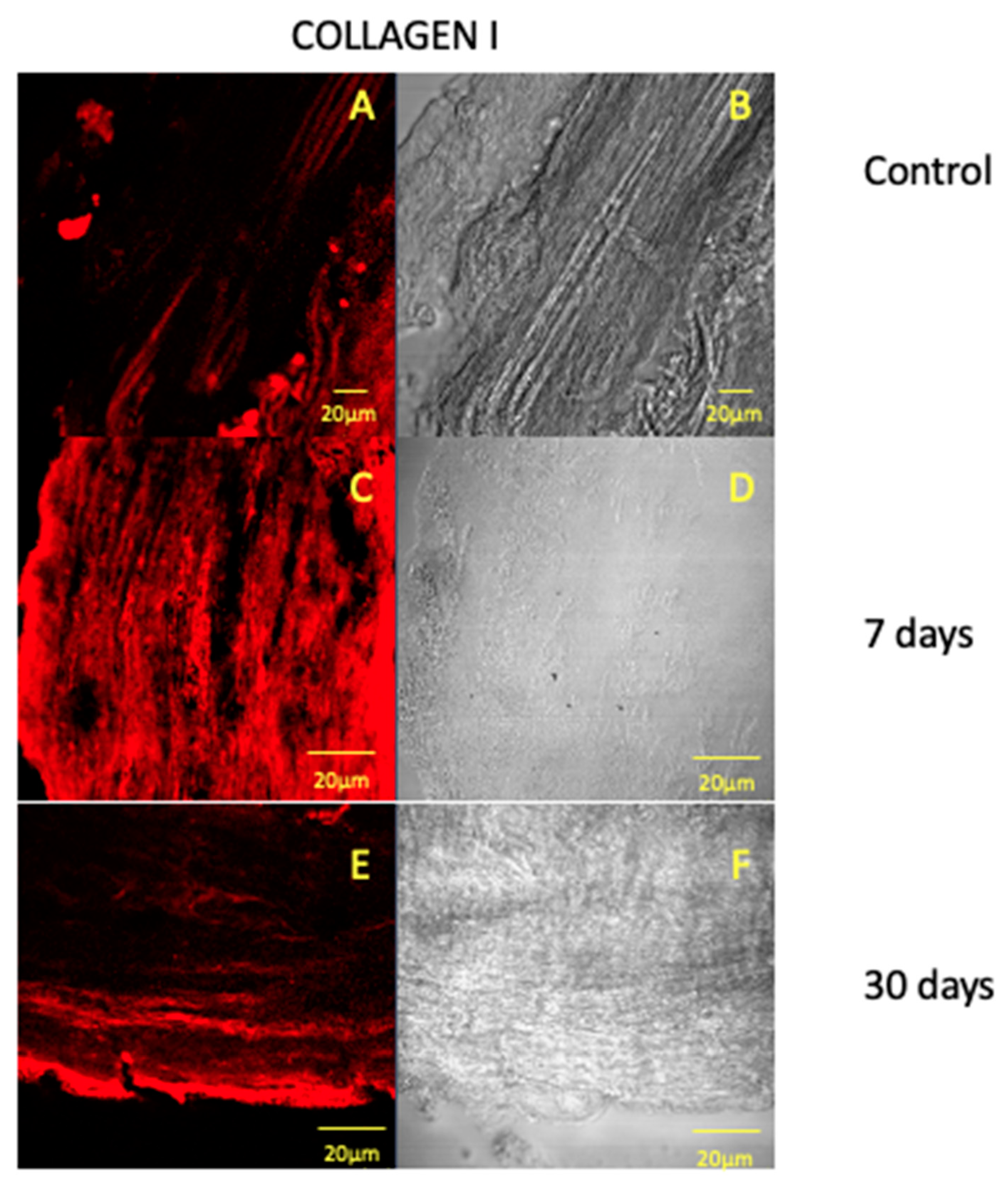

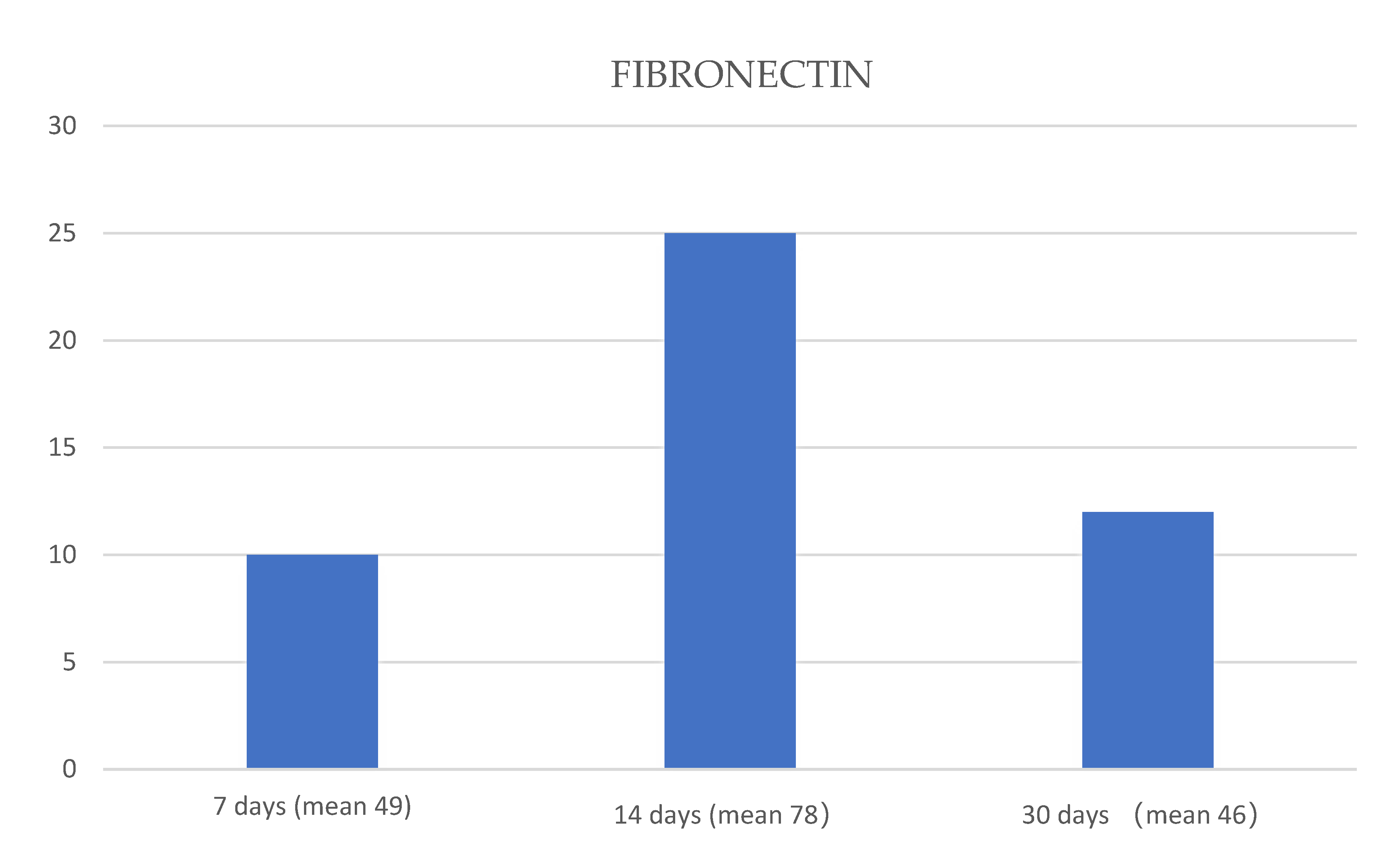
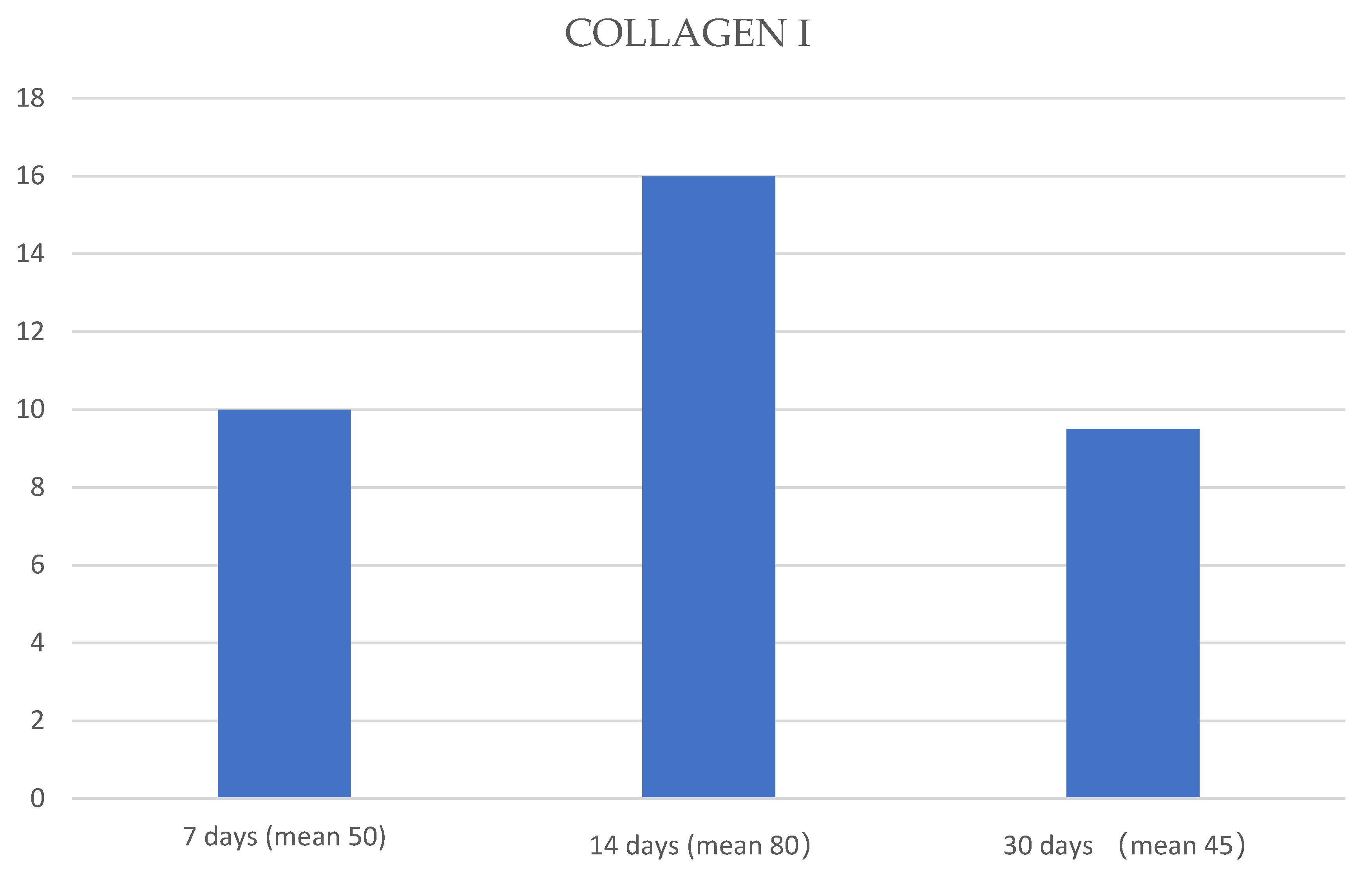
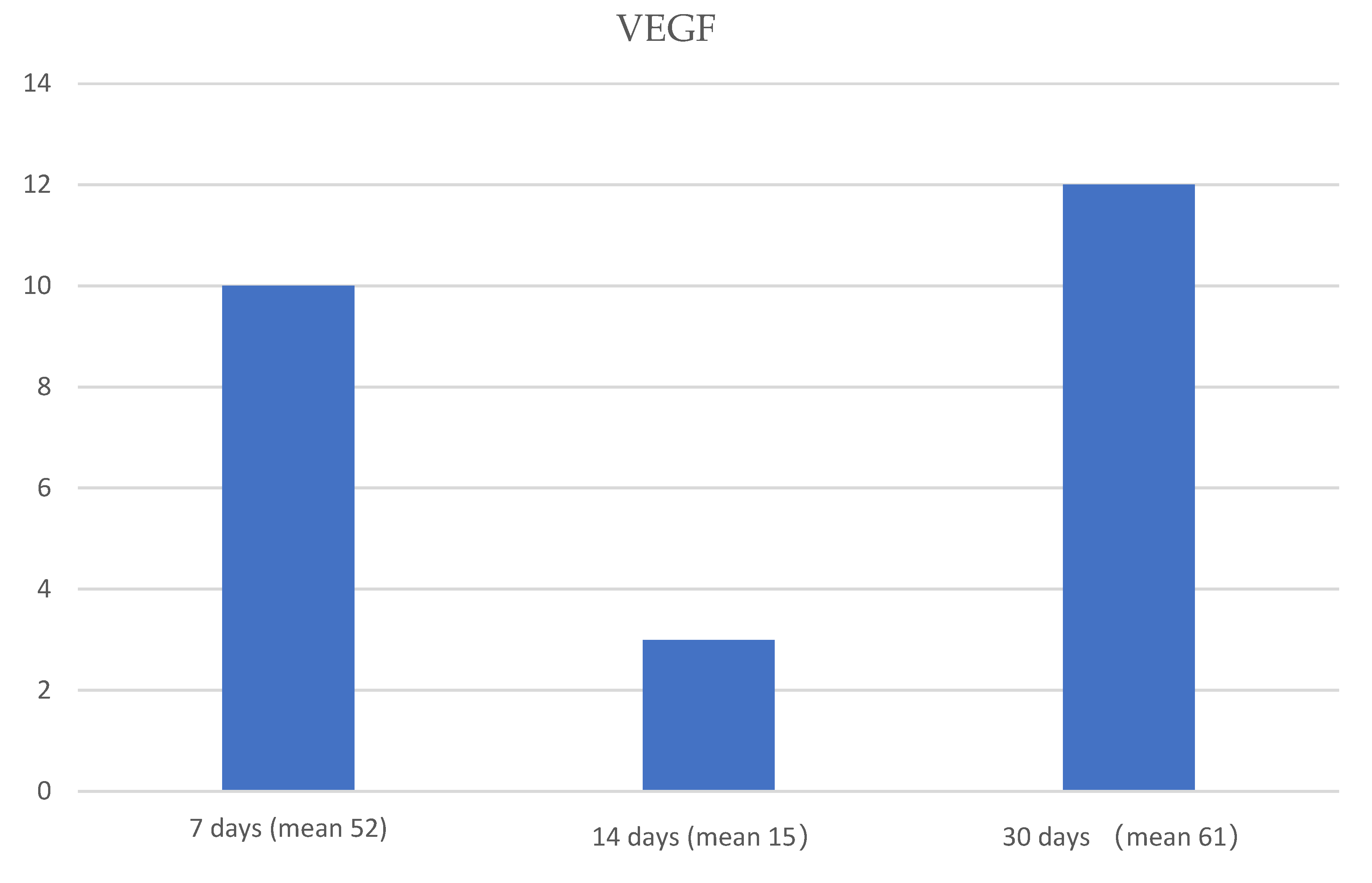
© 2020 by the authors. Licensee MDPI, Basel, Switzerland. This article is an open access article distributed under the terms and conditions of the Creative Commons Attribution (CC BY) license (http://creativecommons.org/licenses/by/4.0/).
Share and Cite
Vermiglio, G.; Centofanti, A.; Matarese, G.; Militi, A.; Matarese, M.; Arco, A.; Nicita, F.; Cutroneo, G. Human Dental Pulp Tissue during Orthodontic Tooth Movement: An Immunofluorescence Study. J. Funct. Morphol. Kinesiol. 2020, 5, 65. https://doi.org/10.3390/jfmk5030065
Vermiglio G, Centofanti A, Matarese G, Militi A, Matarese M, Arco A, Nicita F, Cutroneo G. Human Dental Pulp Tissue during Orthodontic Tooth Movement: An Immunofluorescence Study. Journal of Functional Morphology and Kinesiology. 2020; 5(3):65. https://doi.org/10.3390/jfmk5030065
Chicago/Turabian StyleVermiglio, Giovanna, Antonio Centofanti, Giovanni Matarese, Angela Militi, Marco Matarese, Alba Arco, Fabiana Nicita, and Giuseppina Cutroneo. 2020. "Human Dental Pulp Tissue during Orthodontic Tooth Movement: An Immunofluorescence Study" Journal of Functional Morphology and Kinesiology 5, no. 3: 65. https://doi.org/10.3390/jfmk5030065
APA StyleVermiglio, G., Centofanti, A., Matarese, G., Militi, A., Matarese, M., Arco, A., Nicita, F., & Cutroneo, G. (2020). Human Dental Pulp Tissue during Orthodontic Tooth Movement: An Immunofluorescence Study. Journal of Functional Morphology and Kinesiology, 5(3), 65. https://doi.org/10.3390/jfmk5030065






